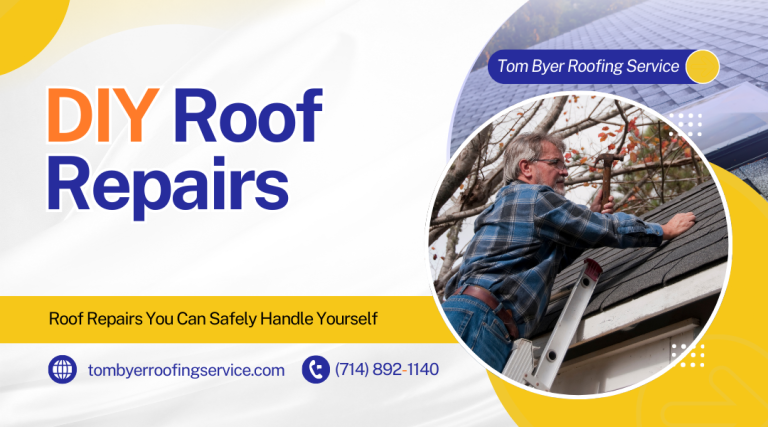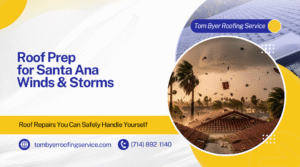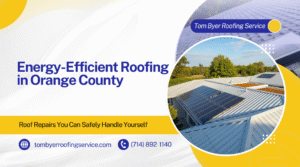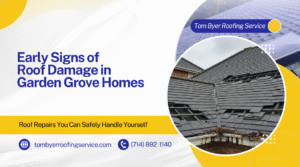When it comes to roof repairs, you might wonder what you can handle on your own and when it’s best to call for professional help. Understanding the limits of your DIY capabilities is crucial to prevent further damage and ensure your safety. Small issues like minor leaks or loose shingles might seem manageable, but identifying serious problems, such as those caused by ice dams or extensive wear, often requires a trained eye.
Regular roof inspections are essential to maintaining the integrity of your home and its energy efficiency. You might find that some repairs, like patching small leaks or clearing debris, are within your skill set. However, if your roof shows signs of significant damage or if you’re unsure how to address a problem, it’s wise to reach out to experts. They can perform a thorough roof inspection and provide solutions that will safeguard your property.
By knowing when to handle repairs and when to call Tom Byer Roofing Service, you can protect your investment and ensure your roof remains in top shape. The right approach will not only save you time and money but also enhance the durability of your roofing system.
Roof Repairs You Can Safely Handle Yourself
Many roof repairs can be done by homeowners without hiring a professional. Understanding what repairs you can manage will save you money and give you a sense of accomplishment. Below are some common roof repairs that are safe for you to tackle.
Fixing Minor Shingle Damage
If you notice missing shingles or damaged shingles, you can often fix this issue yourself. For asphalt shingles, the process is straightforward. Use a utility knife to remove the damaged shingles, cutting around the nails that hold them in place. Once removed, slide the new shingle into place. Ensure that it overlaps correctly with the surrounding shingles.
To secure the new shingle, use roofing nails. Apply roofing cement under the edges to prevent future leaks. Regularly checking your roof can help you catch minor damage before it leads to bigger problems.
Clearing Debris and Cleaning Gutters
Keeping your roof clear of debris is vital for its longevity. You can safely clear off leaves, twigs, and dirt to maintain good drainage. For cleaning gutters, use a sturdy ladder and ensure it’s stable on the ground.
Remove debris from the gutters and consider using a hose to wash them out. Blocked gutters can lead to water damage on your roof and in your home. Aim to clean your gutters at least twice a year, especially after heavy storms.
Sealing Small Leaks and Cracks
If you find small leaks or cracks, you can address them with a sealant. Check areas around vents, chimneys, or seams in the roof for signs of water damage. Use a utility knife to clean the area around the leak.
Choose a high-quality roofing sealant that is appropriate for your roofing material. Apply the sealant generously and smooth it out to ensure a tight seal. Sealing small leaks promptly can prevent bigger issues down the line.
Replacing Broken Flashing
Flashing is essential for directing water away from vulnerable areas on your roof. If you notice damaged flashing, you can replace it. Start by removing the old flashing using a utility knife.
Measure and cut new flashing from metal flashing materials to fit the area properly. Secure it in place with roofing nails and seal the edges with roofing cement. Properly installed flashing helps prevent leaks and water damage.
Tools and Materials You’ll Need
To conduct these DIY roof repairs, you’ll need a few basic tools and materials. Here’s a checklist for your convenience:
- Utility Knife: Essential for cutting shingles and roofing materials.
- Roofing Nails: Required for securing new shingles and flashing.
- High-Quality Sealant: Necessary for sealing leaks and cracks.
- Ladder: Ensure it’s stable for safety while you work.
- Safety Gear: Use gloves and binoculars for observing hard-to-reach areas.
Being equipped with the right tools and materials makes the repairs easier and safer. Always prioritize safety when working on your roof, and if you feel uncertain, don’t hesitate to contact a professional.
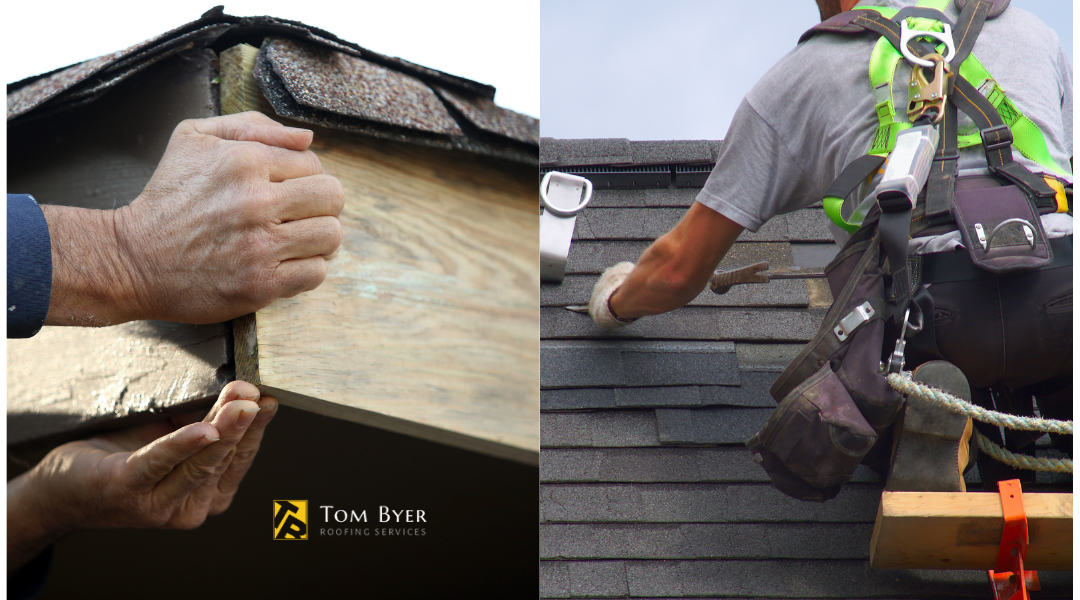
Signs It’s Time to Call a Professional
When it comes to roofing, some issues require immediate professional attention. Recognizing the signs that indicate it’s time to call an expert can help protect your home from further damage and costly repairs. Here are specific situations where professional help is essential.
Widespread Damage or Major Leaks
If you notice multiple leaks or widespread roof damage, it’s crucial to call a professional. Minor leaks can often be repaired easily, but extensive damage may indicate deeper issues.
Look for water stains on ceilings and walls, which can signal major leaks. High winds or heavy storms can also cause significant roof damage, such as missing shingles or dents. These issues can quickly lead to further complications, including mold and structural damage.
A professional will accurately assess the extent of the damage and perform necessary repairs to restore your roof’s integrity.
Sagging Roof Areas or Structural Concerns
A sagging roof is a serious issue that needs immediate attention. This condition often signals structural problems that could compromise your home’s safety.
Sagging may result from excessive weight from snow, ice dams, or other accumulation. It can also suggest that the underlying structure has deteriorated, possibly due to water damage or corrosion.
Ignoring a sagging roof could lead to more severe issues, including complete structural failure. Calling a professional is essential to evaluate and remediate these concerns effectively.
Mold or Extensive Water Damage
The presence of mold or extensive water damage on your roof or inside your home means it’s time to contact an expert. Visible mold growth can spread quickly and poses health risks to you and your family.
Extended water exposure can weaken the materials of your roof, leading to potential collapse or other damage. Look for dark spots, discoloration, or a musty smell, which may signal the presence of moisture and mold.
A professional will assess the extent of water damage and provide solutions to both remove the mold and repair any affected areas.
Roofing Work Above Two Stories
If your roof repairs are above two stories, it’s best to hire a professional. Working at a high elevation increases risks, including falls and accidents.
Ladders, scaffolding, and proper safety equipment are crucial for handling such jobs. However, if you don’t have the right tools or experience, you could put yourself in danger.
Professionals are trained to work safely at heights and will ensure that all repairs are conducted following safety regulations.
Lack of Proper Tools or Safety Equipment
If you find yourself without the proper tools or safety equipment for roofing work, it’s time to call in a professional. Roofing repairs often require specialized tools, like roof jacks, safety harnesses, and other gear.
Using inadequate equipment can lead to ineffective repairs and potential accidents. If you’re unsure about your ability to perform repairs safely and effectively, don’t risk it.
Hiring a professional ensures that repairs are conducted safely and efficiently, utilizing the appropriate tools and expertise to maintain the integrity of your roof.
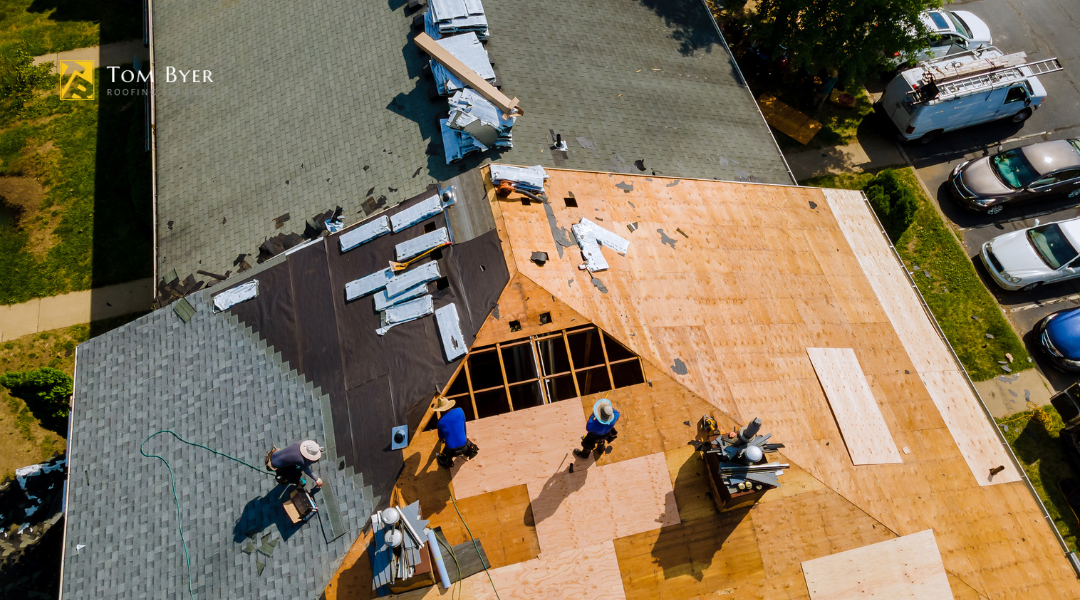
Key Statistics on DIY Roof Repairs vs. Hiring a Pro
When considering roof repairs, it’s important to weigh the costs, risks, and quality of work involved in DIY projects compared to hiring a professional. The statistics below provide insights into these factors.
Cost Comparisons for Common Repairs
DIY roofing repairs can seem appealing for their low upfront costs. For instance, basic patching supplies may only cost you around $50 to $100. In contrast, hiring a professional can range from $200 to $500, depending on the complexity of the job.
However, consider the long-term expenses. If a DIY repair fails, you may need to spend more to fix the issues and hire a pro later. High-quality materials can enhance durability but may raise your initial costs, making professional help more attractive in some cases.
Accident Rates for DIY Roofing Projects
Statistically, DIY roofing poses higher risks for accidents, with nearly 2 million injuries reported annually in home improvement projects. Falls are the leading cause of these incidents, contributing to more than 60% of injuries on roofs.
By contrast, professional roofers are trained to manage risks and follow safety protocols. This training can reduce the likelihood of accidents significantly, giving you peace of mind during repairs. Remember, your safety is paramount when deciding which path to take.
Longevity of DIY Repairs vs. Professional Work
Lastly, the longevity of repairs is a critical factor. Many DIY repairs may last only a few years, especially if materials are low-quality or improperly applied. Research shows that professional repair work typically extends the life of your roof by 20% or more due to proper installation and use of high-quality materials.
In summary, professional work often provides better long-term value through effectiveness and reliability. While DIY repairs can be economical initially, their lifespan may not justify the decision in many cases.
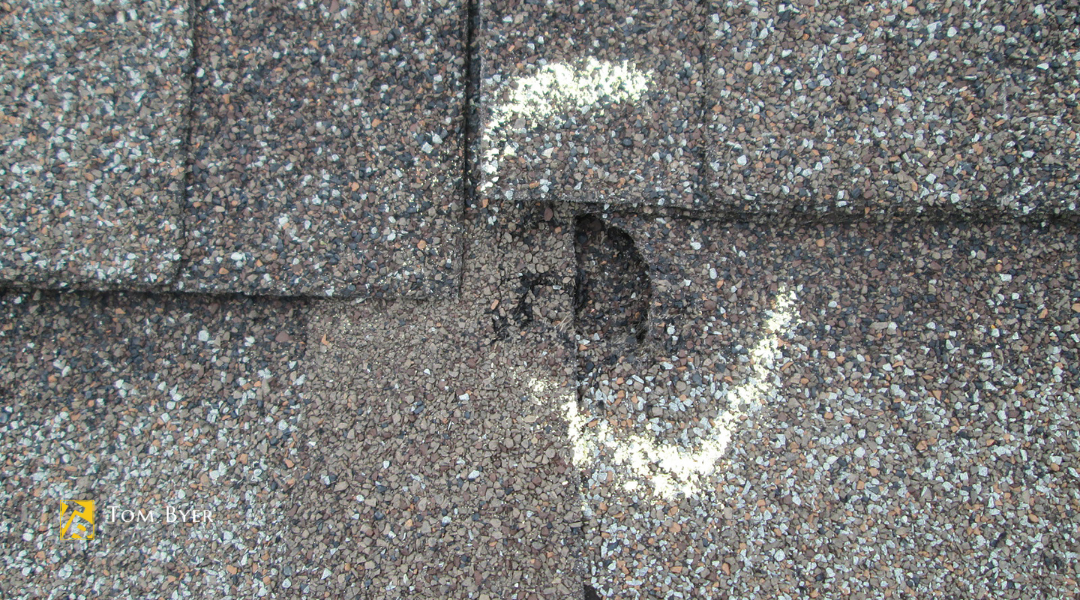
Practical Examples of DIY and Professional Repairs
In this section, you’ll see real-life scenarios that highlight the difference between successful DIY roof repairs and situations where calling a professional was necessary. Understanding these examples can guide your own roofing decisions.
When a Simple Fix Saved Money
You notice a small roof leak after heavy rain. It’s located near a vent flashing. Instead of panicking, you grab some roofing cement.
Carefully apply a bead of the cement around the vent. Ensure you press down firmly to seal any gaps. This simple action can prevent further leaks and water damage.
Not only does this save you from costly repairs, but it also boosts your confidence in handling minor roofing issues. A small investment of time and material can lead to significant savings over time.
A Case of DIY Gone Wrong
In another scenario, a homeowner attempts to replace missing shingles. They buy shingles from a local store without consulting any guides.
When they start the job, they don’t notice that the roof has underlying damage. A heavy rain soon causes more leaks, resulting in significant water damage and mold growth.
This situation illustrates that not all repairs are suited for DIY. When the damage is more than superficial, it’s essential to call a professional. Proper assessment and repair are necessary to avoid escalating problems.
How Professionals Solved a Complex Problem
Sometimes, damage beneath the roof surface is hard to detect. A family in your neighborhood faced such an issue. They noticed water stains but could not find the leak.
After calling a professional roofing contractor, a thorough inspection revealed damaged plywood decking. The contractor replaced the plywood and installed new shingles to prevent future leaks.
Hiring a professional in this case not only fixed the immediate problem but also protected the home from further damage. Their expertise ensured a proper solution, emphasizing the importance of professional help when the extent of damage isn’t clear.
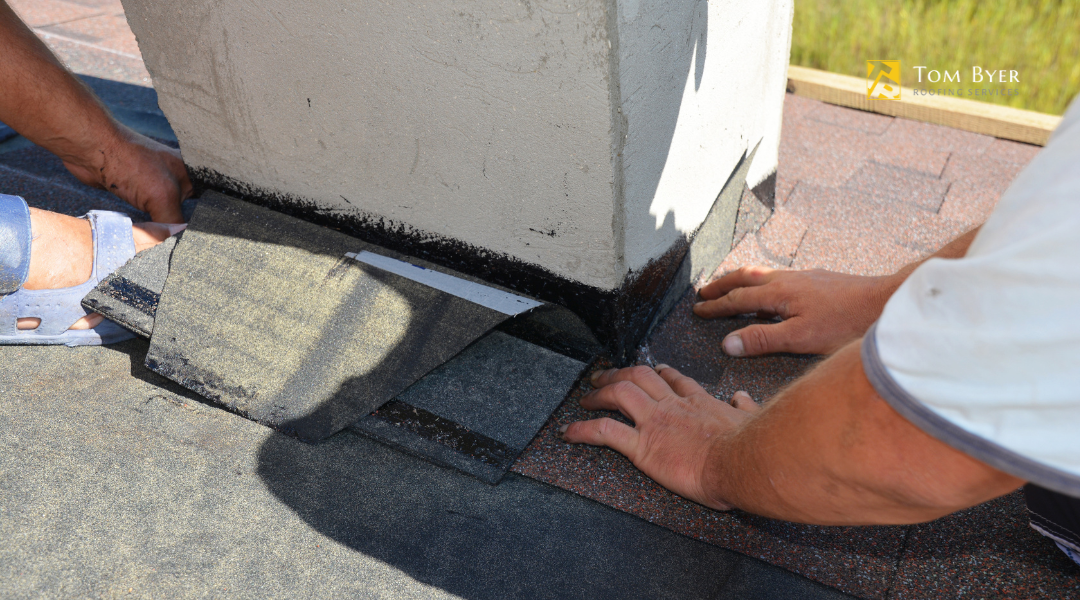
Expert Tips for Safe DIY Roof Repairs
When tackling roof repairs yourself, safety and knowledge are your top priorities. Understanding the risks and regulations, as well as using the right materials and techniques, will keep you secure during your project.
Always Prioritize Safety
Before starting any roof work, ensure you have the proper safety gear. This includes a sturdy helmet, non-slip footwear, and a harness if you’re working on a steep roof. A reliable ladder is also crucial for reaching your roof safely.
Always work with a partner, as this can help in case of an emergency. Familiarize yourself with your surroundings, and be aware of any potential hazards like power lines or unstable surfaces.
Additionally, review local building codes regarding safety equipment requirements. Following these codes can help protect you and your home.
Know Your Roof’s Limits
Not all roof types are suitable for DIY repairs. Inspect your roof and determine its condition before starting work. If your roof has significant damage or is steeply angled, it may be safer to call a professional.
Understand the materials used in your roofing system. Each material has its own repair techniques and limitations. For example, asphalt shingles are easier to handle than tile roofs, which require special care.
Keep in mind the building codes in your area, as they might dictate what repairs you can safely complete. Always prioritize your safety and comfort level.
Invest in Quality Materials
Using the right materials is key to ensuring lasting repairs. Always choose materials that match your roof type to avoid future issues. High-quality shingles, underlayment, and sealants are essential.
When purchasing materials, consider the manufacturer’s guidelines. They often provide advice on compatible products, as well as installation tips. Opt for materials with warranties, so you can ensure they meet building codes in your area.
Buying cheap materials may save money upfront but can lead to higher costs later due to frequent repairs. Invest wisely in materials to ensure your repairs stand the test of time.
When in Doubt, Consult a Professional
If you encounter any aspects of the repair that you don’t fully understand, don’t hesitate to seek expert advice. A professional can provide insights on more complicated issues, such as structural concerns or local building codes.
You might think you’re saving money by doing everything yourself, but certain repairs can put you at risk. If the project requires specialized tools or skills, it’s wise to hire an experienced roofing contractor.
Ultimately, knowing when to step back can save you time, money, and potential hazards. Trust professionals to handle jobs that go beyond your comfort level.
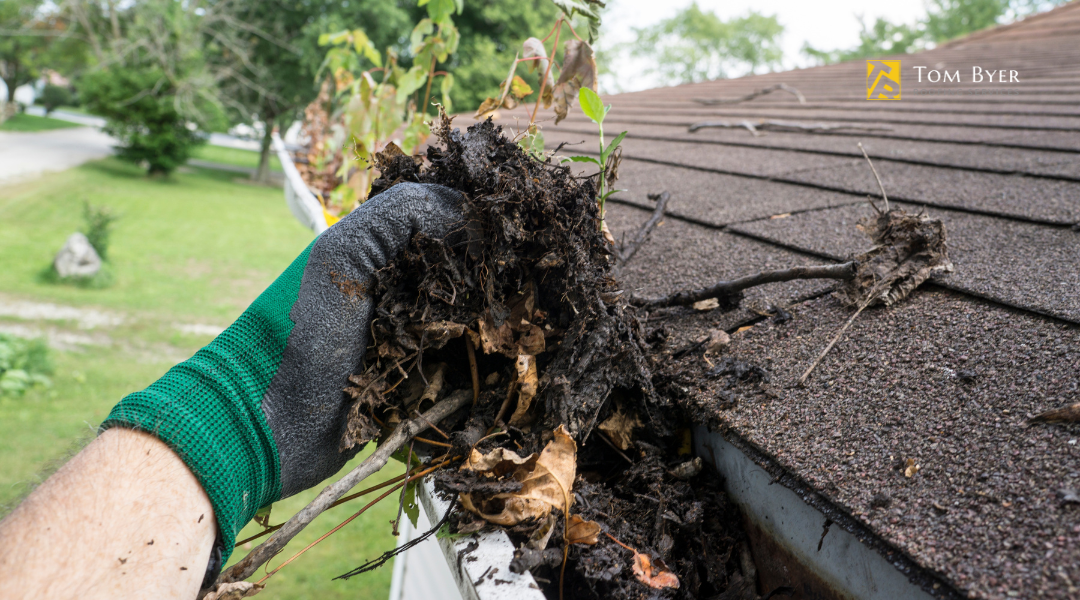
Summary: Balancing DIY with Professional Help
When deciding between DIY roof repairs and hiring a professional, it’s vital to understand what tasks you can safely handle and when you should seek help. The balance between doing it yourself and hiring a roofing contractor can ensure both safety and effectiveness in your home repair projects.
Recap of Safe DIY Repairs
You can manage various minor roof repairs if you have the right tools and knowledge. Tasks like replacing a few damaged shingles or applying roof sealant on small leaks can often be done yourself.
Before you start, make sure to:
- Assess the Damage: Look for easy fixes that don’t involve structural work.
- Choose the Right Materials: Use quality materials that match your existing roof.
- Follow Safety Protocols: Always use a safety harness and other protective gear when on the roof.
For larger issues, like significant leaks or multiple damaged areas, consider contacting a professional roofing company. They can offer a thorough inspection and repair damaged areas effectively.
The Importance of Professional Expertise
Certain situations require the expertise of a roofing contractor for safety and quality assurance. Plumbing repairs, for example, often need expert attention due to the risks involved. Professional contractors understand the complexities of roof structures and can make informed decisions that prevent further damage.
Key reasons to hire a pro include:
- Expertise in Assessing Damage: They can identify underlying issues that may not be immediately visible.
- Access to Specialized Tools: Professionals come equipped with tools not typically found in a home toolkit.
- Long-lasting Solutions: Experienced contractors provide warranties on their work, ensuring that repairs last longer.
In cases of extensive damage, hiring a professional roofing company becomes essential for maintaining the integrity of your home.

